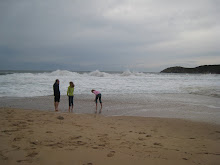 While we were in the Lubéron last week we went on an expedition to find the house Peter Mayle lived in when he wrote A Year in Provence. He's moved house since then, which made me feel marginally less like a stalker and more like a curious pilgrim--curious in both senses. Looking for Mayle's house would, I reasoned, give us a reason for a walk. (A walk is more satisfying if there's a mission involved, even if it's just mailing a letter.) It would take us to a village. (Always good to see another village.) And looking for the house would perhaps give us a sense of place, of what it is like to take a walk in the Lubéron, what it feels like to look out over vineyards and limestone and fallow fields. And this particular walk would, as an added perk, provide a mystery: which mas was the Mayles'?--and, if we were lucky, a solution: this one.
While we were in the Lubéron last week we went on an expedition to find the house Peter Mayle lived in when he wrote A Year in Provence. He's moved house since then, which made me feel marginally less like a stalker and more like a curious pilgrim--curious in both senses. Looking for Mayle's house would, I reasoned, give us a reason for a walk. (A walk is more satisfying if there's a mission involved, even if it's just mailing a letter.) It would take us to a village. (Always good to see another village.) And looking for the house would perhaps give us a sense of place, of what it is like to take a walk in the Lubéron, what it feels like to look out over vineyards and limestone and fallow fields. And this particular walk would, as an added perk, provide a mystery: which mas was the Mayles'?--and, if we were lucky, a solution: this one.G and I went through our copy of A Year in Provence and made careful notes. The house was on a country road between Ménerbes and Bonnieux. It stood at the end of a dirt track that led through grape vines and cherry trees, with the Lubéron parc régional behind it. It was, in the oldest part, two centuries old. There were established shade trees near the house, as well as a stand of cypresses, a few amandiers, and a hedge of rosemary. The house had three wells.
It was ten miles or thereabouts from the house to Bonnieux, which meant that the house stood closer to Ménerbes. We started the research drive in Bonnieux. We'd make the drive, we thought, and then, once we'd scouted, go back on foot. We drove to the top of the village and found, after only one spell of turning around on a narrow road with a hilltop's height drop on one side and a medieval fortification on the other, the road that led to Ménerbes. Off we went, winding along the crest of the hill, the valley on our right and the Lubéron range on our left. About ten miles out of the village we started slowing down for every farmhouse on the left and reviewing our list.
Every mas matched.
They all stood at the end of a dirt track. They all had vineyards and cherry orchards. Rosemary hedges. Cypress trees. Hard to tell about the wells, of course, but every one had its fair share of outbuildings. Which is not to say that they were all the same; they weren't. Some sat closer to the road, some farther back. Some had the shade trees in front, some around to the side. Sometimes the cherry orchard took up the entire frontage; sometimes it was just a few cerisiers. But a provençal mas is like a Gothic cathedral, or a Shakespearean sonnet: unless you know a lot about what you're looking at, they all look pretty much the same.
We retreated to the hotel and to our book. On a closer reading we found a passage where Mayle had written that it was a two kilometer walk to Ménerbes along the trail at the back of the house. Et voilà. Now we had only to find the trail to the village and work from there.
The next morning we put together a picnic and went in search of the trail. The Lubéron, being a national park, is crisscrossed with trails that lead to villages and ruins and outcroppings and, some of them, to nothing at all. We found the trail that ran along the base of the mountain in the direction of Ménerbes and set off down it. But, an hour later, we hadn't found Ménerbes. Then, when we finally found Ménerbes--using the Sierra Club-recommended method of there's a village over there that might be it, and if we follow this dirt road maybe we'll get to it; of course we hadn't remembered a map--we lost the trail. We stood on the village's ramparts with our binoculars and tried to read road signs several kilometers away.
Eventually we walked back along the road in the direction that we thought the car might be in. It was not shaping up to be one of our more successful expeditions. We'd lost our way and walked a kilometer or so uphill through a forest, only to have to turn around and walk back down, never good for morale. We had had to walk on the road at more than one point--and while walking on a country road in Provence is hardly a hardship, we prefer the unpaved. We'd picnicked on a bench in the village, looking out over the vineyards and the Lubéron and trying to figure out exactly where we were in relation to the car, never mind in relation to Peter Mayle's house. And so when, a kilometer or so outside of Ménerbes and an hour later in the day than we had planned to be, we found an old sunken unpaved road leading off through the vineyards towards the mountains, we got out the binoculars before we veered off.
What we could see through those was, we were fairly certain, the trail on which we had begun, the trail we had thought would lead us to Ménerbes, which had led us instead up into the forest until we turned around and started finding our way by sight instead of logic. We took the turn. An orchard on one side, vines on the other, and when the road stopped, we were at the trail where we had started in the morning. And on the trail was a signpost pointing the way to Ménerbes along the route we had just come. 1.8 kilometers, it said. We'd missed it before, seasoned hikers that we are. We retraced our steps to the car and dropped the pack. Let's just look, I said. Just a few meters, it won't make us that much later, let's just see.
Back a little further along the trail from the dead end where we'd left the car, and there was a house with a pool at the back of the property and, between house and pool, a large enclosed courtyard. It was this one, the house. We had found it.
It was an awkward feeling, finding the house. We felt somewhere between literary pilgrims and stalkers. We were consoled by the fact that the Mayles have long since moved to another mas outside another village and so, while we were certainly taking surreptitious photos of someone's house, we weren't taking pictures of someone in particular. We weren't snooping on the house's residents but on the house. It was just a house, the way that any house is just a house, but also the way that the Bronte parsonage, or Carl Sandburg's Connemara, are just houses. A place that you knew in your imagination and never knew if you'd see. It was a goal, a destination, and we had--a half day's walk up and down hill and road, through pastures, and across vineyards and a village--reached it, a hundred meters or so from where we had begun.
Why do we go on pilgrimages? The pilgrims who crossed the Lubéron valley hundreds of years ago were on their way to the shrine of Saint James at Compostello. If they could get there, they believed, they could get that much closer to salvation, or to health, or, maybe, to hope. We weren't looking to save our souls. But instead, maybe, to feed them. To show our souls that the imagined can be made real, the word made flesh or, in this case, stone and vine and tree and path. To show our souls that we can, if not dwell in the imagination, well, we can take a walk alongside it. We can sit on a bench in the sun with our sandwiches, and look down at the vines growing in their orderly rows, vineyards stretching as far as we could see across the valley, and, as Saint James' brother put it, receive from the fullness of it all grace upon grace. It was a good walk.






































I love this! This is exactly the kind of adventure/discovery that thrills me. Thanks for sharing it - I just found your blog and am really enjoying it.
ReplyDeleteI can't believe he sold the house! It a strange feeling to think that pilgrimage spots like this change hands. Great detective work though. Are you sure it wasn't already listed on Google Earth?
ReplyDelete